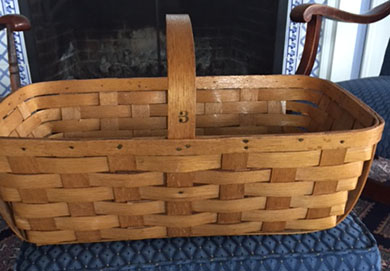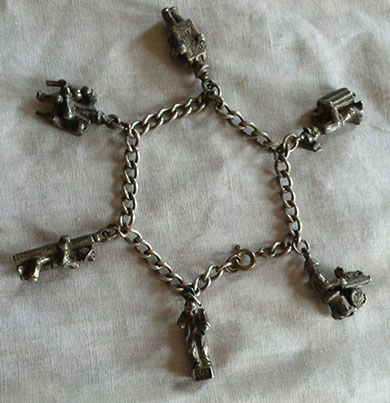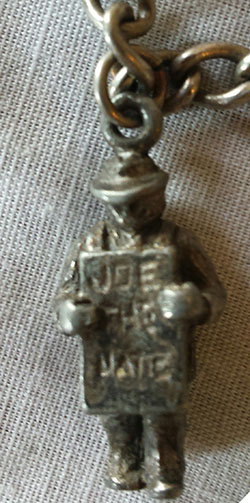 |
|
|||
 |
 |
|||
Copyright © Harry Rinker, LLC 2016 Questions
and Answers
QUESTION: I recently purchased a splint laundry basket and was told by the dealer that it is likely period Shaker made. He sold it to me cheap ($30.00). Did the Shakers make baskets that could be this inexpensive or was the seller just making me feel good about buying on old basket? I live in northern New Hampshire. Three nearby Shaker communities include two in New Hampshire (Enfield and Canterbury) and one in Maine.
ANSWER: The good news is that I have no problem being the bad guy. The bad news is your laundry basket falls into the same phrase the Three Little Pigs used when answering the Big Bad Wolf – “not by the hair of my chinny chin chin.” One look at the construction of your laundry basket in the photographs that accompanied your email was sufficient evidence to assign a non-Shaker origin. The Shakers were pattern driven, that is to say, they made products that conformed to narrow design parameters. Although there were slight differences between the same products made at different Shaker communities, the overall design was basic. Shaker laundry baskets had side handles and not an inverted “C” shaped central handle. The weave on the sides were very tight, often so dense no light could pass through. The shape was more chest-like than basket-like. The bottom of the basket was treated differently.
The $30.00 price was a warning signal. “Beware of bargains” is one of the basic rules of authenticating. A period Shaker laundry basket in very good or better condition sells in excess of $500.00. The aging and wear on your basked is not consistent with an older basket. The wood looks new. It does not have the patina that comes over time from exposure to the dirt and chemicals in the air. If you push the horizontal body splats up and down, you will see little discoloration. Although I have not handled the basket, the handle most likely does not exhibit the underside smoothness that would occur as the basket was picked up, carried, and put down through years of use. I have little respect for the “woulda, coulda, shoulda” sellers. Antiques and collectibles buyers on the whole are gullible. They accept what sellers tell them, primarily if the story is an especially good one. Survival in the antiques and collectibles game requires a constant questioning mentality. Whenever anyone, dealer or expert, tells you something, your first reaction should be to ask the person to show you the proof to back up the claim. QUESTION: I recently acquired a charm bracelet with a Depression era theme. There are six silver-plated charms of Depression era workers – a man standing on a box marked “SOAP,” a worker pushing an old fashioned street sweeper, a worker pushing a wheelbarrow, a man on a bench with a round jug, a man leaning on a lamppost, and an unemployed man with a sandwich board marked “Joe the Hatter.” The charms are on a curb pattern chain bracelet. An expert suggested it was made and sold by working families to help the unemployed. I would appreciate any information you can provide about the bracelet. – DG, Nashua, NH, Email Question
ANSWER: The charm bracelet was not a common form during the late 1920s and 1930s. In my travels, I saw a Bakelite WWII charm bracelet with a series of Civilian Defense charms. Had it been for sale, I would have purchased it. It was neat. The big charm bracelet craze occurred in the 1950s through the end of the 1960s. Charm bracelets from this period contained charms commemorating specific events in the wearer’s life. The craze also included grandmothers and mothers creating charm bracelets that contained male and female heads engraved with the names of husbands, children, and grandchildren. The depressing nature of the theme of your charm bracelet is puzzling. Charm bracelets normally have an upbeat and/or holistic theme. The charms are meant to be magical. In attempting to research your bracelet, I found that you offered it on eBay shortly after contacting to me. You listed it with a starting bid of $45.00. When the listing closed on July 25, 2016, it did not sell. Is this enough to conclude the value of the charm bracelet is worth less than $45.00? No. The “right” buyers were not searching eBay that week. If I saw the bracelet at an antiques flea market, mall, shop, or show priced between $35.00 and $45.00, I would likely be a buyer even though I do not collect charm bracelets. I would buy the charm bracelet because of it neatness and add it to my “research this someday” pile. Your charm bracelet is not a one-of-a-kind bracelet. It was mass-produced. Hence, there have to be others extant. Patience is a key to researching antiques and collectibles. Finding answers takes time. If any “Rinker on Collectibles” listeners can shed more light on the origins of this charm bracelet, send your thoughts to harrylrinker@aol.com. Finally, in a world where I question everything, I am not totally convinced the bracelet dates from pre-World War II. The theme and construction suggests this possibility, but, ???. QUESTION: I have a collection of Junior Deluxe Edition books, published in the mid-1950s in Garden City, New York. Titles include “Five Little Peppers and How They Grew” by Margaret Sidney, “The Prince and The Pauper” by Mark Twain, and “Two Years Before the Mast” by Richard Henry Dana, Jr. Would any of these be worth anything? – R, Minersville, PA, Email Question ANSWER: The moment I see “Garden City, New York” on the title page or copyright information in a book, I immediately think inexpensive edition usually printed on pulp paper. Nelson Doubleday and J. P. Lippincott Co. had books printed there. Information on Junior Deluxe Editions Children’s books is scarce. One source suggests there were close to 90 titles in the series. A working list of 37 titles is available on: www.librarything.com/publisherseries/Junior+Deluxe+Editions. “Two Years Before the Mast” is not on that list. Some books had dust jackets and others did not. Those titles without dust jackets have covers and front and back fly leaves that feature a composite of silhouette style images related to the book’s theme. A variety of illustrators were used. The series lasted from 1947 to 1968. The secondary market for Junior Deluxe Edition titles is weak. Abebooks.com asking prices begin around $4.00 ($1.00 for the book and $3.00 for shipping). The vast majority of listings are under $10.00, shipping included. Popular classics list between $15.00 and $25.00. Once again, remember none of these books sold. QUESTION: At a recent garage sale, I purchased a demi-lune picture frame with eight chambered pieces comprising its edge. The glass is fogged. It appears there is some sort of dried flower arrangement behind it. A paper label on the back reads: “Beauty (script) / FOR THE / HOME / SUNGOTT ART STUDIOS / NEW YORK.” I bought the frame to reuse it but hesitated when I saw the sticker on the back. What are your thoughts? – AT, Oakdate, MN, Email Question ANSWER: According to one internet source, “Sungott Art Studios of New York was [an] art distribution company that was most likely in operation in the 1950s and 1960s...The company specialized in mass-production home furnishing and decorative items that were sold at a low price.” Many of the items Sungott produced had a strong 18th or 19th century appearance. [https://www.reference.com/art-literature/sungott-art-studios-new-york-4fed6976d60b9ff6] My suggestion is simple. Remove the backing, throw out the dried floral arrangement, clean the glass, and put whatever pleases you into the frame. As things stand at the moment, the only value is in the frame, which is between $20.00 and $25.00. Harry L. Rinker welcomes questions from readers about
collectibles, those mass-produced items from the twentieth and twenty-first centuries.
Selected letters will be answered in this column.
Harry cannot provide personal answers.
Photos and other material submitted cannot be
returned.
Send your questions to: Rinker on Collectibles, 5955 Mill
Point Court SE, Kentwood, MI 49512.
You also can e-mail your questions to
harrylrinker@aol.com.
Only e-mails containing a full name and mailing address
will be considered.
You can listen
and participate in
WHATCHA GOT?, Harry’s
antiques and collectibles radio call-in show, on Sunday mornings between 8:00 AM
and 10:00 AM Eastern Time.
If you
cannot find it on a station in your area,
WHATCHA GOT?
streams live on the Internet at www.gcnlive.com.
SELL, KEEP OR TOSS?: HOW TO DOWNSIZE A HOME,
SETTLE AN ESTATE, AND APPRAISE PERSONAL PROPERTY
(House of Collectibles, an imprint of Random House Information Group, $17.99),
Harry’s latest book, is available at your favorite bookstore and via
www.harryrinker.com.
|
||||



